Learn more about the intruiging biochemistry of non-coding RNAs in this article.

Image Credit: Love Employee/Shutterstock.com
Non-coding RNAs (ncRNAs) are RNA molecules that are not translated into proteins but, in many cases, are functional in a variety of cellular processes. The role of ncRNAs has only become appreciated in recent decades owing to various experimental and bioinformatics studies, and this article will introduce ncRNAs and some of their diverse functions.
What Are the Types of ncRNAs?
There are multiple types of ncRNA that fulfill differing roles, such as transfer RNA (tRNA), which facilitates the link between messenger RNA (mRNA) and proteins; ribosomal RNA, which participates in the synthesis of proteins within the ribosome; micro RNAs (miRNAs), which are involved in RNA silencing by complementary binding, and therefore post-transcriptional regulation of gene expression; and many others.
Typically, ncRNAs are under 200 nucleotides long, differentiating them from long non-coding RNAs (lncRNAs), though many ncRNAs of the same type fall on either side of this divide.
One surprising outcome of the completion of the human genome project was the realization that protein-coding sequences occupy only around 1.5% of the genome, with large regions considered junk DNA with little purpose, often consisting of repeat sequences.
However, artificial intelligence (machine learning or deep learning) studies indicate that the majority of the human genome is capable of producing transcripts of varying length, many of which are conserved in other species, suggesting functional purpose.
Many ncRNAs perform housekeeping duties within the cell on a fundamental level, and are present throughout the animal kingdom. They often act as catalysts and scaffolds that facilitate interactions between other biomolecules and can thereby alter the rate of this interaction by their abundance.
Through similar interactions, ncRNAs are able to bind to proteins and other biomolecules as ligands, and are capable of inducing conformational changes or allowing specific coupling with other biomolecules, acting to initiate signaling events. There is also some evidence that ncRNAs are able to leave the cell and potentially enter the circulatory system, possibly acting as a hormone to affect distal organs, and in some cases as useful disease biomarkers.
How Are Bioinformatics Tools Used to Understand ncRNA Interactions?
As ncRNA are capable of such a broad range of cellular functions, interacting directly or indirectly with proteins, RNA, and other biomolecules to produce an effect, their study benefits greatly from the use of bioinformatics tools, namely computing technologies that are able to sort through the vast quantities of data put out by the cell.
Databases of biomolecular structure and function are available openly to researchers that allow information on particular biomolecules and their interactions to be accumulated, and thus associated with biological states in a predictive manner. For example, where an aberrant expression of a certain ncRNA is found more commonly amongst cancer patients, its involvement may be implicated in disease progression.
One subcategory of this type of bioinformatics tool, specific to miRNA, is Heterogeneous Graph Inference for miRNA-Disease Association prediction (HGIMDA), which utilizes experimentally confirmed data to predict the association between miRNA and disease. A more recently developed predictive tool termed Path-Based miRNA-Disease Association (PB-MDA) operates in a similar manner, also including comparisons of miRNA-miRNA and disease-disease similarity between patients.
Deep learning programs can consider huge quantities of information relating to the genome, proteome, transcriptome, and metabolome of the cell, effectively describing the entire biological entity and its network of interacting biomolecules. They can be expensive to establish and run, however, and the quality of their conclusions is dependent on the input data, suitability of the biological question, and availability of information.

Image Credit: bluesroad/Shutterstock.com
Can ncRNAs be Used as Biomarkers?
ncRNAs provide diverse regulatory functions within the cell, acting as the interface between genomics and proteomics. Many diseases result in altered ncRNA expression, particularly cancer, a disease associated with an aberrant genome. This includes miRNAs, resulting in altered protein expression; Y RNAs, which are involved in the initiation of DNA replication; telomerase RNA, which acts to prime telomerase for cell division; and a plethora of others of which the function is unknown, such as most lncRNAs.
Altered ncRNA expression may be a result of other properties of the disease, i.e. because cell division is upregulated then so is Y RNA, or actually be associated with tumor formation, progression, and metastasis. For example, lncRNA Linc00707 is upregulated in many types of cancer and is associated with regulating the expression of proteins that promote aggressive cancer characteristics.
In Alzheimer’s disease, beta-site amyloid precursor protein cleaving enzyme 1 antisense (BACE1-AS) RNA is upregulated, which acts to stabilize BACE1. BACE1 is associated with beta-amyloid plaque formation, and thus Alzheimer’s progression may be driven at least partly by dysregulation of the antisense ncRNA.
The Evolutionary Conservation of ncRNA
As ncRNA does not encode for the transcription of proteins vital to the function of the cell, it may be thought that they may be less well-conserved evolutionarily. However, ncRNAs are increasingly being realized to be playing vital regulatory functions within cells, and a large proportion exhibit extensive evolutionary conservation.
miRNAs, in particular, which are known to perform extensive regulatory functions in binding with target mRNA and inhibiting protein transcription, are found in identical sequences throughout the animal or plant kingdoms.
Moran et al. (2017) suggest that the last common ancestor between plants and animals likely had miRNA, but point out that the high turnover rate and loss of miRNA sequences over generations could imply convergent evolution, where miRNA independently evolved, possibly from siRNA-like molecules, multiple times in each lineage.
Though thought to be less strongly conserved than ncRNA, lncRNA is also increasingly recognized to perform vital cellular functions and thus exhibits extensive conservation over generations. Many thousands of lncRNA are transcribed from the genome, estimated at around 16,000 to over 100,000 by differing sources, and they perform a variety of intra- and intercellular, as well as potentially systemic functions, the majority of which are as yet unknown.
Most lncRNA is transcribed by Pol II, and were presumed to be generated in a similar manner to mRNAs. Recent studies have revealed, however, that lncRNA is transcribed, processed, and sometimes exported from the cell in novel manners dependent on their fate. A greater proportion of lncRNAs are found in the nucleus than mRNAs, are less abundantly expressed, and seem to be less evolutionarily conserved.
lncRNAs are often observed to accumulate on the chromatin, the mixture of DNA and proteins that constitute the chromosomes and are less easily spliced than mRNAs, encouraging nuclear retention.
Many lncRNAs are exported to the cytosol; it is thought predominantly by the same processes and export pathways as mRNA; as they contain fewer exons than mRNAs they may preferentially use particular pathways that do not rely on the presence of exons, such as the nuclear RNA export factor 1 (NXF1) pathway, which shuttles the lncRNA into the cytoplasm.
Some lncRNA that reach the cytoplasm are brought into the mitochondria to be sorted and are thereafter involved in mRNA stabilization, exosome generation, and exportation, as well as a host of additional mechanisms not yet entirely understood.
Conclusion
Perhaps the most intriguing function of ncRNA is regulating gene expression, being the interface between genomics and proteomics. Where genes are ultimately translated into mRNA that goes on to initiate and facilitate protein synthesis, ncRNAs modulate this interaction in a manner that has not yet elucidated. How ncRNAs are involved in broader physiological processes is still less well understood but may play a large role in future therapeutics.
mRNA-based therapeutics and vaccines have taken a spotlight recently owing to the massive success of the mRNA-based COVID-19 vaccines, along with other mRNA-based medicines, and thus manipulation of the ncRNAs influencing mRNA generation and a host of additional cellular processes would introduce another revolution in medicine.
Sources:
Fu, X.-D. (2014). Non-coding RNA: a new frontier in regulatory biology. National Science Review, 1(2), pp. 190–204. doi.org/10.1093/nsr/nwu008
Saadeldin, M. (2021). Highlights from the ‘Noncoding RNA world: From Mechanism to Therapy’ conference, July 21-23, 2021. World Academy of Sciences Journal, 3(6). doi.org/10.3892/wasj.2021.135
Statello, L., et al. (2021). Gene regulation by long non-coding RNAs and its biological functions. Nature Reviews Molecular Cell Biology, 22(2), pp. 96–118. doi.org/10.1038/s41580-020-00315-9
Rincón-Riveros, A., et al. (2021). Bioinformatic Tools for the Analysis and Prediction of ncRNA Interactions. International Journal of Molecular Sciences, 22(21), p. 11397. doi.org/10.3390/ijms222111397
Qu, Z., & Adelson, D. L. (2012). Evolutionary conservation and functional roles of ncRNA. Frontiers in Genetics, 3. doi.org/10.3389/fgene.2012.00205
Moran, Y., et al. (2017). The evolutionary origin of plant and animal microRNAs. Nature Ecology & Evolution, 1(3), p. 0027. doi.org/10.1038/s41559-016-0027
Last Updated: Dec 28, 2023